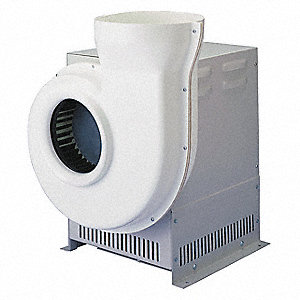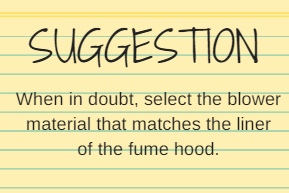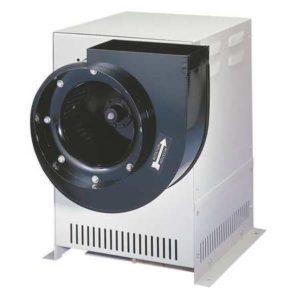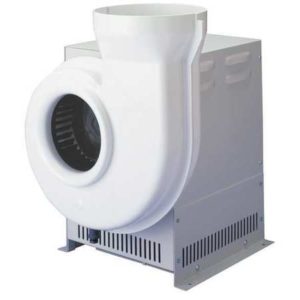For fume hoods that do not have an integral blower built-in to them, choosing the right blower is a significant decision. This crucial piece of equipment not only safeguards your health by removing hazardous fumes but also enhances the overall functionality of your lab. It’s the device that moves air through the fume hood and pushes contaminated air out from the hood, through ductwork, to the outside. The blower must work in conjunction with the fume hood itself and the associated ductwork.
In this guide, we’ll delve into the essential factors you need to consider, including blower types, materials, sizes, and performance features, to make an informed decision that ensures safety and efficiency in your lab operations.
Understanding Fume Hood Blowers
The type of blower is directly related to the intended use of the fume hood. If the fume hood is used for venting non-toxic materials, an epoxy-coated steel blower may be the best option. If the fume hood’s primary use is mixing acids, an acid-resistant blower made of PVC, polypropylene or fiberglass-reinforced plastic may be the best option.

Fiberglass for moderate to highly corrosive conditions.


Coated Steel for low to moderately corrosive applications.

PVC for perchloric acid and other corrosive applications.
For volatile work, there are explosion-proof and spark-resistant blowers. These blowers are typically made of fiberglass and have an enclosed motor. This enclosure ensures that potential fumes in the air stream do not encounter an electrical spark or even the motor itself. The fan blades are also designed to be non-sparking.
Choosing the Right Size and Performance
Finding the right size blower is critical to the performance of your fume hood. A blower that is too weak will not properly remove contaminated air. Likewise, a blower that is too strong could overpower the ductwork and create turbulence around equipment or containers. Each fume hood manufacturer will provide the amount of air needed to operate the fume hood, stated in cubic feet per minute (CFM). No measurement should be less than 75 CFM. This will ensure adequate airflow to prevent vapors from escaping when the sash is open.
Further, all fume hoods and ductwork systems create static pressure. This pressure is taken into account when determining the size of the blower. Such factors that should be considered are duct diameter, length of the ductwork, the number of elbows in the ductwork, and the degree of the elbow bend (e.g. 90-degree elbow bends restrict airflow differently than 45-degree elbow bends). These factors, along with the corresponding sash height create static pressure and affect volumetric flow. After this information is compiled, and static pressure is known, it is much easier to determine the proper size blower for your fume hood.
Expert Tips and Best Practices
Choosing and properly sizing a blower can be a complex process. There are many factors involved and many details that play a role and ultimately impact the performance of the hood. To ensure that your fume hood will work properly, consult an expert to discuss your needs and determine a solution that will benefit your laboratory.
Learn about maintaining your fume hood blower for sustained performance and recognizing the signs that indicate it’s time for an upgrade. And if your fume hood blower is broken, a replacement blower is an option. But it may be time for the fume hood to be upgraded: When is it Time to Upgrade Your Fume Hood?
FAQs
- How do I know if my fume hood blower needs an upgrade? Signs include inefficient air removal, noticeable wear, or if it doesn’t meet the latest safety standards.
- Can the same blower be used for different types of fume hoods? It depends on the blower’s compatibility with the hood’s material and the type of substances being handled.
- How often should fume hood blowers be inspected? Regular inspections, at least annually, are recommended to ensure they function correctly and safely.
- Do fume hood blowers require special maintenance? Maintenance typically involves routine checks for airflow efficiency, cleanliness, and motor functionality to ensure optimal performance.
- What size fume hood do I need? The fume hood size that you need will depend on factors such as the equipment you plan to use inside the hood, the type of work you will be performing, and how large your physical space is.

